The Beautiful and Elegant Kentia Palm from Lord Howe Island
INTRODUCTION
Howea forsteriana is a single trunk, pinnate palm tree from Lord Howe Island, an island east of Australia between Australia and New Zealand. It is known as the Kentia Palm or Kentia, but also goes by the names Paradise Palm, Sentry Palm and the Thatch Palm. It is a fairly slow growing and elegant palm species that is often planted in groups of three or more plants together. It is an ideal palm for growing inside the house and does very well in the coastal areas of Southern California. This article will discuss this species, it’s characteristics and culture, and it’s usage in the home and garden.
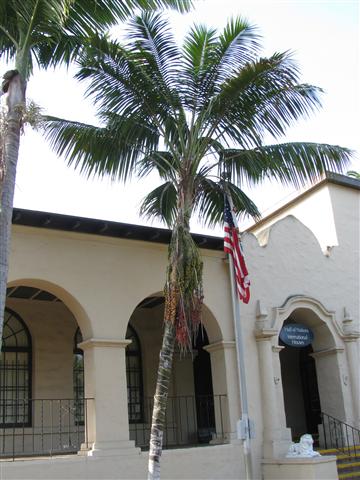
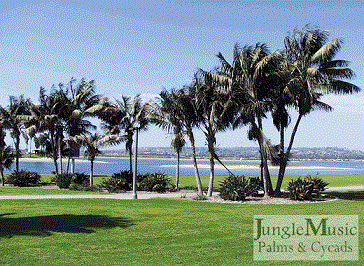
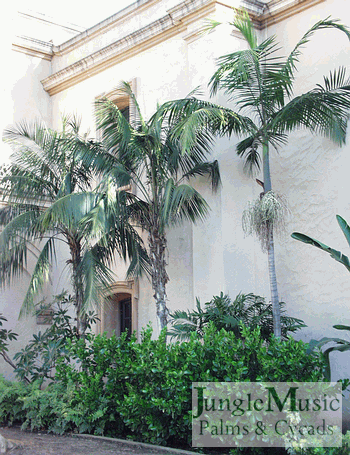
Palm on right. Photo taken in Balboa Park
HISTORY OF THE KENTIA PALM
Howea is a genus that is native to the rather small Lord Howe Island. This island is off the southeast coast of Australia. On this island there are several good sized mountains. On this island there are four known species of palms that are endemic. Among these is the genus Howea and there are two species in this genus: H. forsteriana and H. belmoreana. It is the former, the Kentia Palm, that we dealing with in this article.
Lord Howe Island was discovered in the late 1700’s. Explorers there noted the predominant plant was the Howea forsteriana. where it grows close to sea level and a moderate distance up the mountains. Plants were returned home to Europe in the mid 1800’s and it was quickly discovered that this species was a wonderful interior plant and was very beautiful and graceful. During this time of initial exportation, this species received the name, “The Kentia Palm”. To this date, this species still carries this common name. The derivation of this common name given is unclear, but the Latin name honored an Australian politician, William Forester. Obviously the name “Howea” gives reference to the native locality of Lord Howe Island.
NATURAL HABITAT OF HOWEA FORSTERIANA
Lord Howe Island is about 7 miles long and has several mountains. These mountains give a wide variety of growing environments as one ascends to higher elevations. It is interesting that, as one goes to these higher elevations on the island, the natively found species change. Howea forsteriana is the predominant species on the island and is the species which lives at the lowest elevations, seldom seen over 400 meters elevation. On the island, there are many colonies of this species, some with heights up to fifty feet. They are in soil with good drainage and received moderate rainfall.
DESCRIPTION OF THE SPECIES, HOWEA FORSTERIANA
GENERAL APPEARANCE
Howea forsteriana is a single trunk, monoecious pinnate palm that has a full crown of arching leaves with somewhat drooping leaflets. The leaves are about 10 to 12 feet long and the leaflets 18 to 30 inches. The crown width is about 16 feet. The trunk diameter varies with cultivation but is typically 6 to 12 inches in diameter. Cultural deprivation can result in thinner trunks and plants that receive excellent nutrition can be a bit over 12 inches. Although there are reports of plants on Lord Howe Island having a trunk height of 60 feet, this is unusual to see in almost any domestic planting. A typical very old single trunk specimen will have 30 to 40 feet of trunk at maturity in domestic plantings. Growing in sun, I tell people typically to expect a height of 30 feet in 30 years. Plants grown under canopy tend to be taller and have longer, stretched out leaves. Also, in shade the leaflets are held in a more horizontal plane that the leaflets of specimens grown in full sun which have more drooping or hanging leaflets.
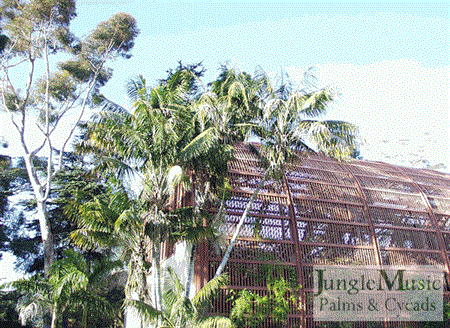
San Diego and have been in the ground for about 40 years
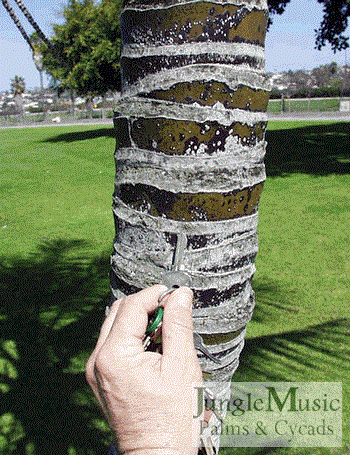
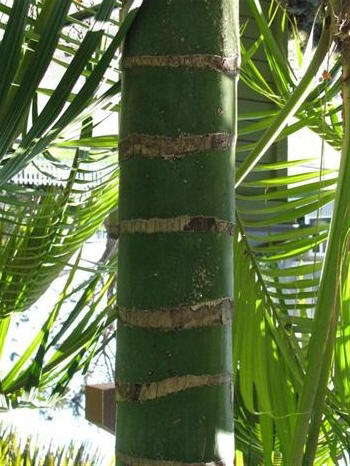
TRUNK AND LEAVES
Many people think of the Kentia Palm as being a suckering palm. It is not; it is a single trunk species. But, nurserymen will plant two, three, four or more plants in the same pot. This fools customers into thinking that Kentias sucker. They absolutely do not. Start with a single in a pot and you’ll always just have one plant. There is no crown shaft on the Howea palms. The trunk may be swollen at the base and below the leaves this species has a collection of thatched old leaf bases. These will eventually fall off the tree or may be manually removed when loose. Below these old leaf bases there is a tubular trunk with prominent rings. In the sun, this trunk is a tan color. In shade, the Kentia palm may maintain a beautiful green color with easily seen rings. Because of individual competition, multiple plants in the same area grow more slowly than a single trunk plant.
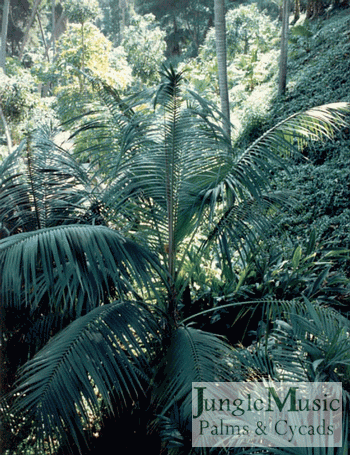
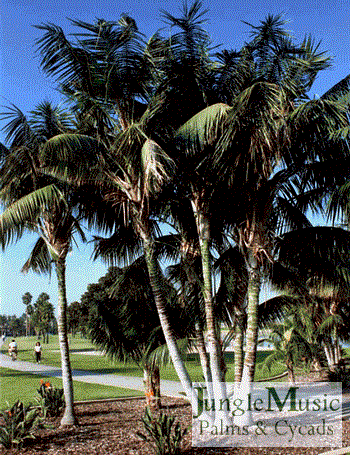
FLOWERS AND SEEDS
Flowers emerge from within the leaves or occasionally right below the lowest leaves. They initially grow upwards and are often grouped as multiple flower spikes side by side. When fruits are set, the cluster of seeds appear tightly packed along a long non-branching flower spike that hangs down toward the ground. It seems that the weight of all the seeds pulls the spike downwards. Seed color is initially green and over twelve to twenty-four months turn colors from green to yellow to orange-red and finally to a black color mixed in with the red. It is not unusual to see seeds of varying ages on the same tree. This demonstrates how they take a long time to mature. When collecting seeds, it is best to get the older red seeds for better germination. Of note, there is an active business of exporting seeds of Howea forsteriana around the world from Lord Howe Island.
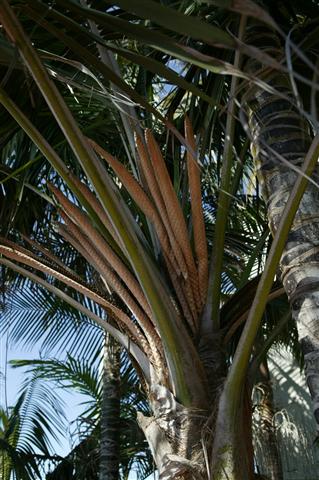
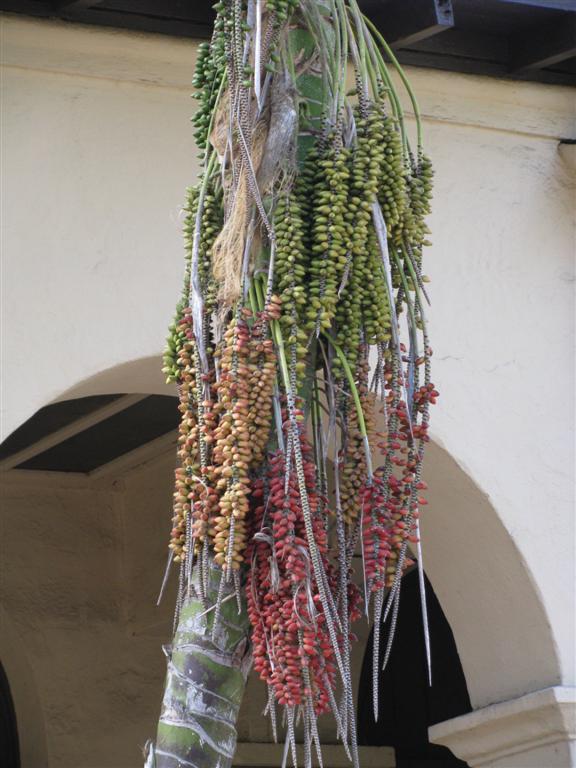
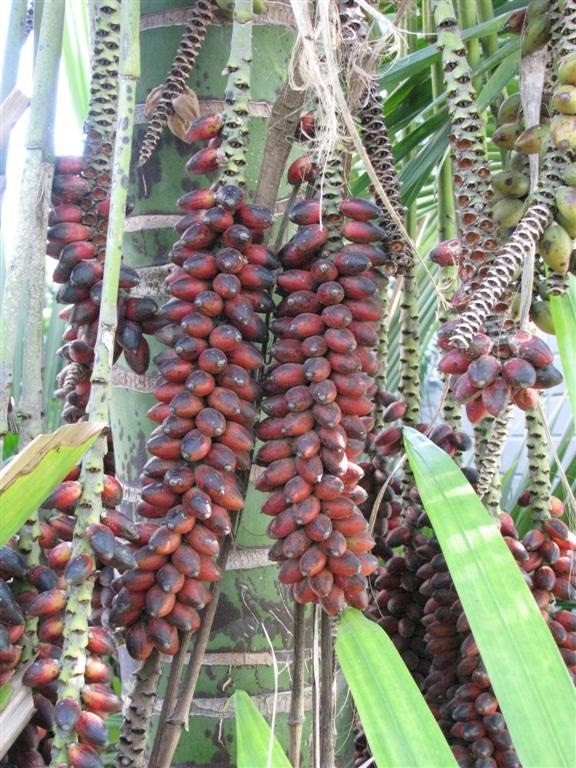
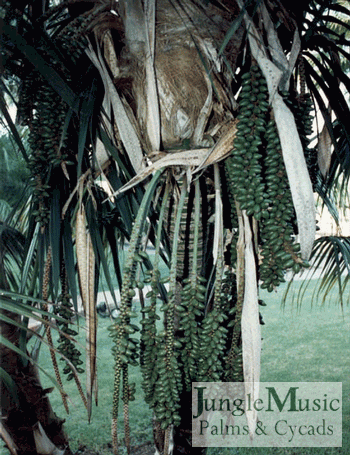
LEAF COLOR
Leaf color of Howea forsteriana depends on the conditions under which it is growing. In shade or filtered light, the leaves are dark olive green. With a lot of sun, leaves become more yellow green but still attractive. Also, when a plant is grown in full sun, the leaflets tend to hang downwards and droop. My suspicion that the different orientation of the leaves in regards to sunlight is the plants way of not being exposed to too much direct sunlight. In inland areas, this species must be given protection from bright sun or the leaves can sunburn and show brown splotches.
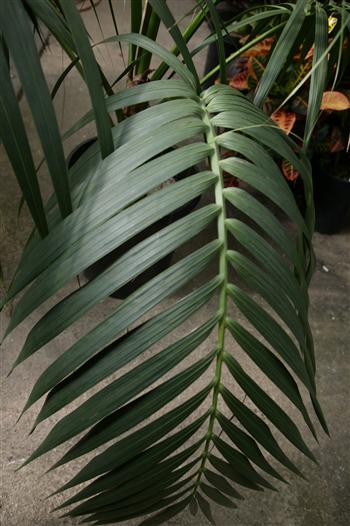
leaf in filtered light on nursery plant

USAGE OF HOWEA FORSTERIANA IN THE GARDEN
Along the coast and to about ten miles inland, the Kentia Palm does quite well in full sun. At distances of twenty miles or greater in our locality, it does better if it doesn’t see sun all day long. It can be planted as a single trunked plant or in clusters of several plants together. The latter is something that is done by the nurseryman. Or, you can plant a colony of three or more closely approximated plants in the same general area (see picture below). But, plants that are multiples from the onset will have trunks close together with perhaps some curve in the trunk. It is quite common in such multiples to see a “stair-stepping” of the plants with a small, medium and larger plant over time. This is a nice feature of growth habit as it gives a longer life to lower foliage, thus a fuller looking clump. Single specimens will grow more rapidly than multiples. Planting of a multiple specimen with four or five individual plants in the clump will make an ideal biological barrier to block visibility from a neighbor peering into your yard. If, after many years, the clump’s trunks all mature and are overhead, one can merely plant a few more smaller plants at the base of the original plants.
Howea forsteriana can be planted up to three or four feet from the house or a fence. Over time, plants may lean away from any structure. Roots of the Kentia Palm will only rarely disturb house foundations or sidewalks. Their root system is not large. They can also successfully be grown below the canopy of overhead, taller trees. Kentias also make ideal patio plants or containerized specimens. Their slow growth keeps them from quickly getting too tall for the container.
Although Kentias would not be considered a “fast” grower, over time they will develop trunk and serve as a canopy-forming species. From a 15g plant, one could expect to develop such canopy in about eight to ten years. Queens, Kings and Fishtail Palms are much faster canopy forming species, but nothing beats the beauty of the Howea.

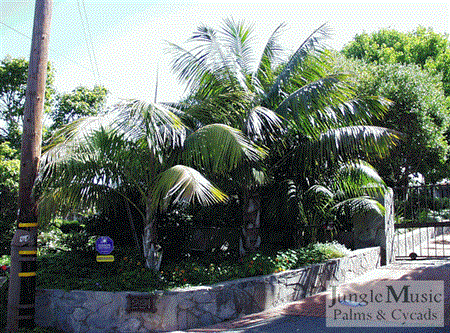
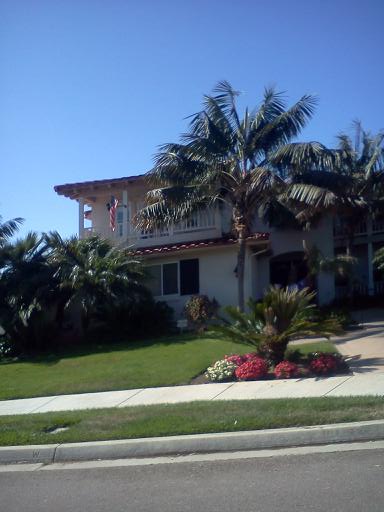
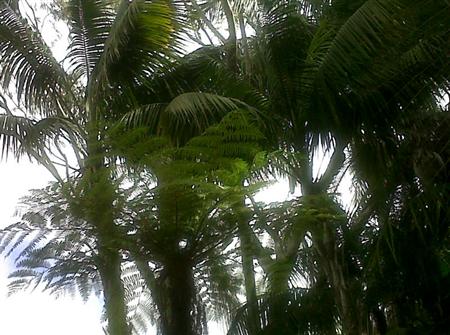
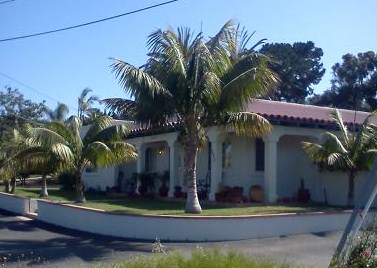
street retainer wall

as opposed to a “multiple”


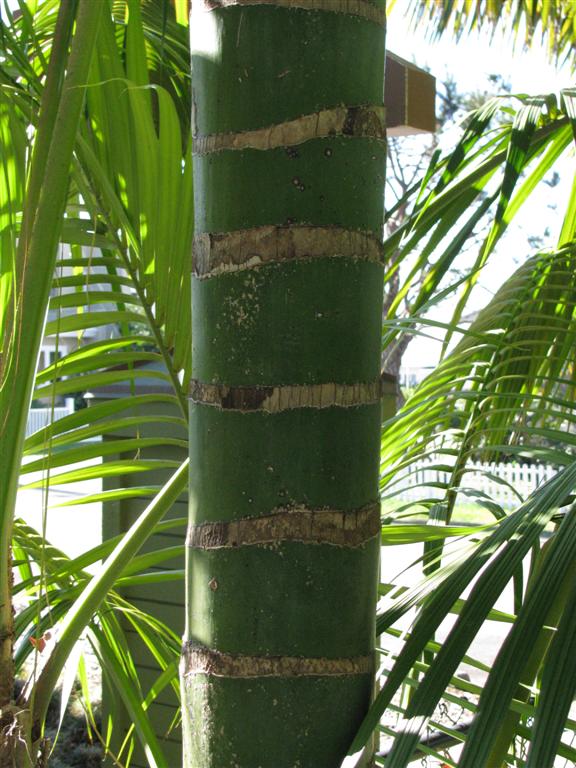
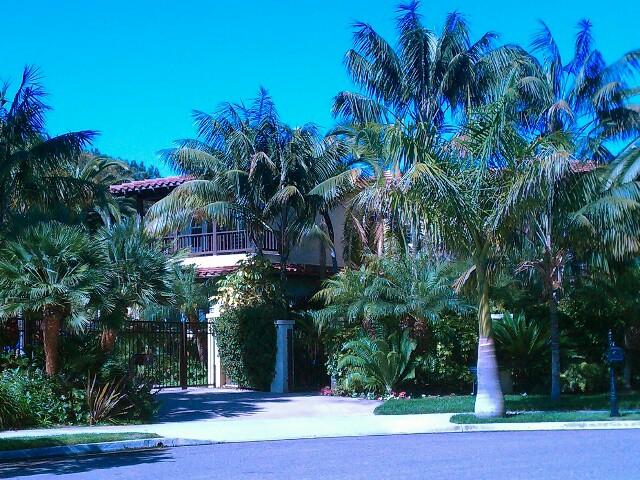
home above roofline. In the foreground is a Royal Palm.
HOWEA FORSTERIANA AS A HOUSE PLANT
It has been known since the 1800’s that Howea forsteriana make wonderful interior palms. They prefer medium interior light and would do well with a direct eastern or western window exposure. Hours of direct southern light through a bright window may be a too intense for this species. As a house plant their growth is rather slow. This means typically they will not reach the ceiling rapidly. The lower leaves do have some horizontal spread so one has to anticipate this. They can be pruned to just have upright foliage, but one does not want to overdo this. Another nice feature of this species is that one can “root restrict” the Kentia Palm in an undersized container and it still grows well (to an extent). This means you can get a rather good sized plant in not too large of a container, saving on pottery costs. In a container, a Kentia palm will not grow as fast nor get as big as the pictures you see at this article.
Regarding the amount of light you have in your interior location, darker locations give longer leaves and perhaps slower growth. If inside in darker conditions, you’ll find that leaves will stretch out more. It’s as if the plants are “looking for light”. There is no doubt that an interior grown Kentia or one grown in shade has longer leaves than one grown in full sun.
If one has enough room, Howea make a wonderful entryway palm or a good plant for a foyer. The leaves are unarmed and soft. You will see interior Kentias in everything from a small local barber shop to grand lobbies in huge, expensive hotels. Even a stand alone large specimen with ten feet of trunk looks wonderful inside in the right space. Photos below are examples of nursery plants that would be put into beautiful ceramic pots for interior usage.
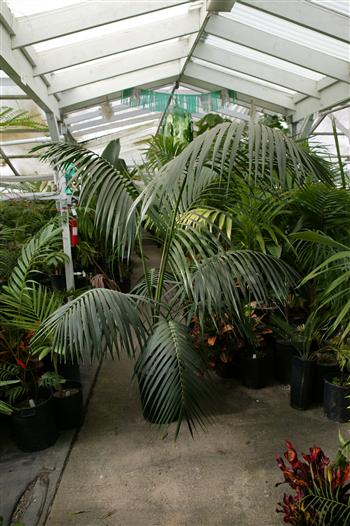
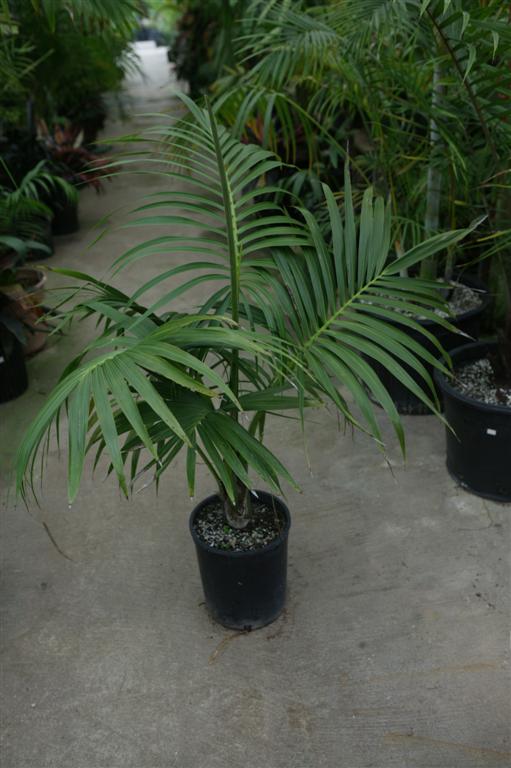
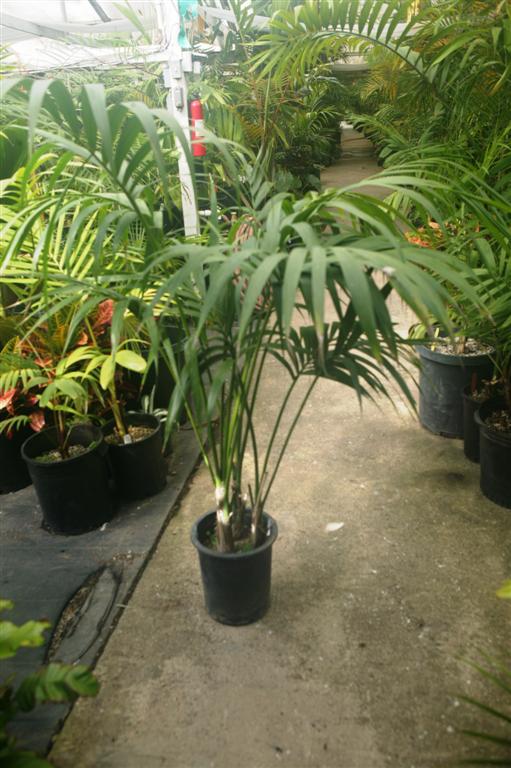
OUTDOOR CULTURE OF HOWEA FORSTERIANA
Kentia Palms are not difficult to grow, either in the garden or inside the home. But, there are simple rules to follow.
First and most important is to realize that this species tolerates temperatures down to about 25-26 degrees. Plants exposed to 24 to 26 degrees will show burn, but may survive. Temperatures of 23 degrees or less will usually kill the Kentia Palm. Overhead canopy can help protect this species if you are in a colder area. Regarding high temperatures, Howea forsteriana can tolerate temperatures of 100 degrees or warmer if not in direct sun. But, the combination of hot weather and intense sun is something they do not like. Also, high temperatures and high humidity / rainfall are difficult for them as well. This is why Kentia Palms do better in coastal Southern California than in areas like Southern Florida or Hawaii.
The second key to success with Kentias is to pick the right sun exposure. As mentioned above, if you are in Southern California and within six or eight miles from the ocean, full sun can be tolerated. Or, if you choose, filtered light conditions work well. For locations further inland, morning sun or filtered light is needed. Also, in this locality, Santa Ana conditions can be hard on Howeas. These are dry desert winds that blow toward the ocean and happen from time to time. If you live in a desert type climate, you must grow this species in shade or fairly heavy filtered light.
Kentia Palms like rich, loamy soil with good drainage and require average water. But, they also do fairly well in clay soil. Typically watering the plants two to three times a week in summer is more than adequate. In a wet winter, rainwater alone may be adequate for this species. Like other palms, Howea forsteriana like a fertilizer with the “ratio” (N/P/K) of about 3:1:3 or 3:1:2 with microelements. Therefore, a fertilizer that is 12/4/12 or 15/5/10 would be great. Also, if possible, use a slow release fertilizer. These cost more but will prevent root burn. A plant that is too yellow may be this way because of too much sun or lack of nutrition. Often a few doses of blood meal will green it up.
Another observation about the Kentia Palm is that specimens planted in strong filtered light may put on vertical trunk faster than specimens in full sun. The picture above of a trunk from filtered light shows a greater inter-nodal distance between the growth rings. This shows how, with each leaf produced, there is more trunk formation than with the adjacent, sun grown plant where the rings are very close to each other. Obviously, the availability of water and fertilizer play a role in this, but filtered light-grown specimens seem to grow faster. This is probably because they are looking for more light. Be aware, however, that plants in deep shade often stall altogether with little trunk formation.

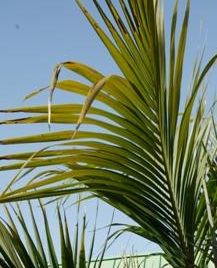
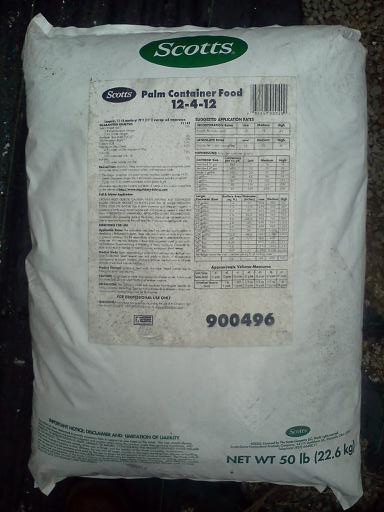
PRUNING AND CLEANING THE TRUNK OF THE KENTIA PALM
Typically one prunes off lower leaves on this species when they discolor or look ugly. One starts with the oldest (lowest) leaves and works his way up the stem. Leaves should be removed by pruning close to the trunk leaving a minimal amount of petiole. It is possible to over-prune and just leave the upward leaves. This would prevent the horizontal spread of the plant. But, this is hard on the plant because it looses chlorophyll from those healthy green leaves that were removed. On an outdoor specimen, such sever pruning can lead to a thinner trunk or “penciling” at the top of the trunk. If one does not want to have seeds, immature blossoms can be removed when they emerge. The plant will most likely continue to throw more blossoms to make up for your removal of earlier blossoms.
As mentioned above, Howeas will retain old leaf bases (what’s left after you cut off a leaf) and this give a thatch like appearance below the crown of green leaves. These retained leaf bases on the trunk can be easily pulled off the trunk when they are aged and ready, giving a cleaner appearing trunk. Try not to force them off by forcefully tearing them from the trunk or cutting at them. This can scar the trunk (forever) and introduce infection into the plant. A surprise to people is that, when you remove these old leaf bases, the trunk you expose will tend to be yellow in color. This yellow color will convert to green if the plant is in the shade or a tan color if in sun. Sometimes you can get a black sunburn on the trunk after removing the old leaf bases if harsh sunlight hits directly on the trunk. This is recognized by a rapid development of black areas only on the sun exposed side. This should heal over time.
The sequence of photos below shows the characteristics of the trunk with old bases and the gentle removal of an old leaf base that easily pulls off the trunk. Note that the attached edge of the old leaf base has rotted on its own and is not freshly torn tissue. Because of this, it is easily pulled from the trunk. If still attached and hard to remove with a firm pull, we recommend leaving it intact for later removal. The lowest old leaf bases are almost always the easiest to remove. So, start pulling them off from the bottom of the thatch and work your way upwards. If you choose not to remove them, over time they will drop to the ground on their own. As you clean a trunk, also remove old blossoms at the same time. They are the long thin objects coming from the trunk in the photos below.

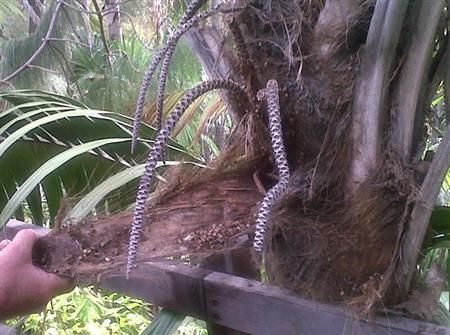
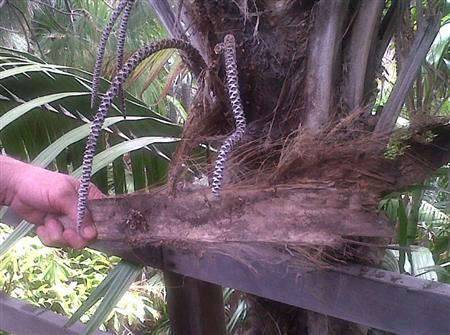
Cracks in the trunk can occur if a plant has received a lot of water and fertilizer. Often these cracks will ooze a dark sap. I do not recommend doing anything with these cracks. Just leave them alone. If you pack them with filler, you might create an internal closed space where fungus and root can breed.
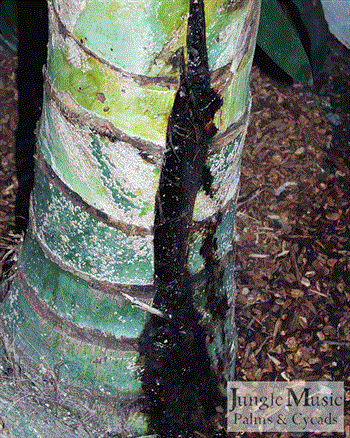
GERMINATING SEEDS OF HOWEA FORSTERIANA
When collecting Kentia palm seeds, try to get seeds that have a nice orange or red color, sometimes blotchy with brown or black. Try not to pick green seeds. It is common practice for seedsmen who sell Kentia seeds to try to offer green seeds. They will tell you “green seeds are better”. This is not true. They are just trying to market seeds before their time. Although every nurseryman has his own favorite technique to germinate these seeds, I’ve found a few things to be true. First, they are slow to germinate, typically taking about 6 months or more. Also, you do not have to remove the fruit to germinate seeds on the Kentia. The fruit is very thin and in my experience, doesn’t prevent germination. Also, I’ve found that bottom heat (in my locality) is not necessary and even results in lesser germination rates. Too much heat will prevent germination altogether.
My favorite technique is to collect ripe seeds from the tree, scatter them around the base of the trunk on the garden surface, and to throw some soil or mulch over them. The sprinkler system will hit them three times a week with routine watering and this is all it takes. It seems I get at least a 50% germination rate with this technique and it’s so easy. Little germinated seedlings can easily be dug from this loose soil and potted up. Remember to put several together in each pot if you want to grow “multiples”.
DIGGING AND TRANSPLANTING OF HOWEA FORSTERIANA
An interesting thing about the Kentia Palm is its ability to tolerate being dug, even as a sizeable specimen, and moved to another location. Kentia Palms with as much as twenty feet of woody trunk are routinely moved with success. Such transplants are not without the risk of loss of the plant, but can be done by palm movers with experience. And, surprisingly, rather small root balls are required for successful movement of the plants. Typically 36 to 48 inch root balls will be adequate for most large Kentia Palms. After transplant, very heavy watering is often needed and root and leaf stimulants and hormones can be used to improve results. (note: Jungle Music offers such large specimens for sale)
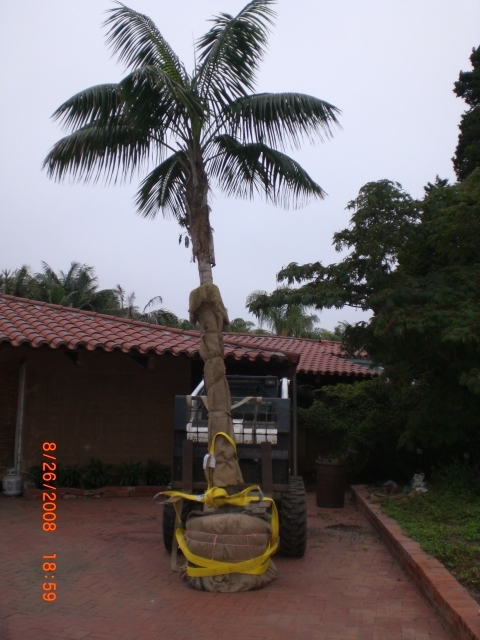
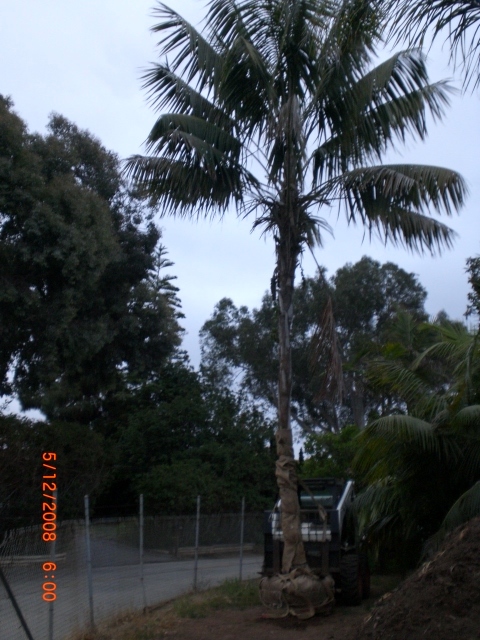
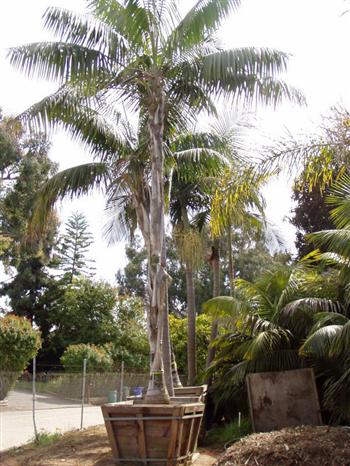
THE HOWEA “LEANING DISEASE”
There is a rather peculiar malady well known to those growing Howea Forsteriana in the garden. This is the “Howea Leaning Disease”. it should be called a “syndrome” because no definite cause is known. It affects older plants, typically Kentias with five to ten feet of trunk or more. The crown of leaves begins bending to one side. I’ve seen trees where there is a 90 degree angle to the trunk and leaves. Eventually this typically kills the plant. Surprisingly, with a multiple trunk plant, it can affect just one of the trunks. If you live in Southern California and look for it, you will see affected plants. But, it occurs in most areas of the country where Kentias can grow. l
Over the several previous decades there has been conjecture that this disease is due to a fungus or a “non-bacterial” cause. But, there has not been a proven cause as of yet. Treatment prescribed was usually to treat with a fungicide, increase the frequency and volume of watering, and to cut off leaves on the side of the crown that was leaning. This treatment does, on occasion, remedy the condition. Other proposed treatments are an insecticide for mites and pouring hydrogen peroxide down the crown of the tree. The rationale of cutting off leaves on the leaning size was to “take weight off the crown”. More recently there’s been speculation that this disease is caused by a Boron deficiency. After looking, similar leaning crowns have been seen in quite a few other types of palm trees, so this leaning disease is not unique to just Kentias.
It is surprising that many people who have stricken Howeas in their garden don’t even notice this problem until it is extreme. The photo below may represent such a case. I just drove around for a while and saw this example.
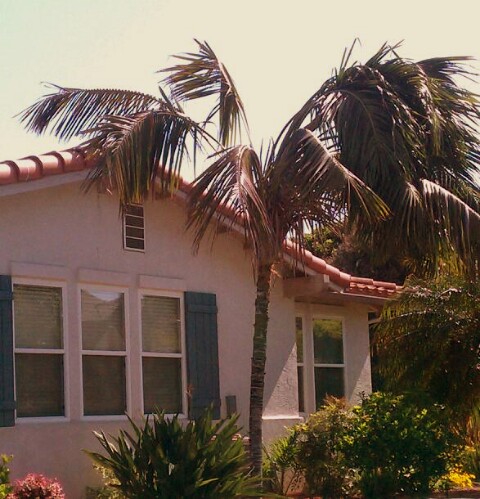
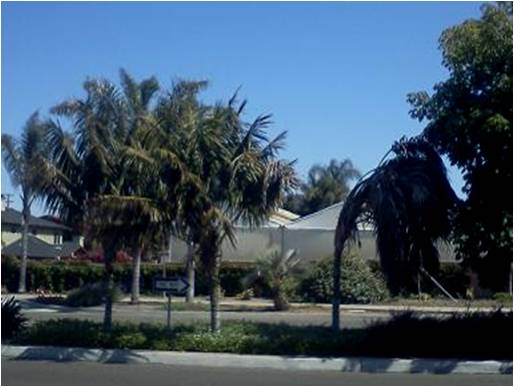
CULTURE OF KENTIA PALMS INDOORS
Growing of the Kentia Palm inside the house is really not that difficult. It is one of the best interior palms known. They prefer less than intense full sun through a window. Adjacent to a window where they get nice indirect light is about perfect. That do not like dark rooms. They like rich well draining soil, sometimes even with a little topsoil mixed in. A simple store bought mix of peat moss and perlite is not very good for the Growing of the Kentia Palm inside the house is really not that difficult. It is one of the best interior palms known. They prefer less than intense full sun through a window. Adjacent to a window where they get nice indirect light is about perfect. That do not like dark rooms. They like rich well draining soil, sometimes even with a little topsoil mixed in. A simple store bought mix of peat moss and perlite is not very good for the Howea Palm. It is best to add more organic mater, sand, or topsoil. Watering should be done when the top inch of soil becomes dry. Fertilizer used should not be too strong and organic fertilizers are fine Never fertilize a dry palm. It is best to add more organic mater, sand, or topsoil. Watering should be done when the top inch of soil becomes dry. Fertilizer used should not be too strong and organic fertilizers are fine Never fertilize Kentias when the soil is dry; it is best to fertilizer several hours or a day after a heavy watering.
Maladies and diseases with interior grown Kentias seem to be of two types: pests and salt build up in the soil. Typical pest seen most often include types of scale and mealy bugs. Humid conditions and poor air circulation can lead to black sooty mold whereas overly dry conditions can cause red spider infestations. For all of the pest problems, take the plant outside (in the shade) and hose down the foliage with a good blast of water from a hose end nozzle. The two main pests seen on Kentia Palms are scale and mealy bugs. Humid conditions and poor air circulation can lead to black sooty mold whereas overly dry conditions can cause red spider infestations.
Another major problem for the Kentia palm inside is the buildup of salt in the soil. When one waters a houseplant, the water evaporates. This leaves behind any salts that were in the water utilized. Salts do not evaporate; only water evaporates into the air. Over time these left-behind salts build up and increase the salinity of the soil. This gives tip burning of the leaflets and eventually death of leaves and ultimately the entire plant. This gradual build up of salt in the water is a universal problem and not unique to just the Kentia Palm. If you utilize municipal water, almost any interior house plant will die over time. There are several remedies and preventions. First, use distilled or reverse osmosis water when watering. Do not confuse reverse osmosis water with “filtered water”; they are not the same. The other thing you can do is take the plant outdoors and leach the soil. This means watering it for ten or fifteen minutes continually so that water is gushing out the bottom. This rinses out excess salts in the soil. While you are doing this, give the foliage a bath of water as well. Then, when the plant has dried out, bring it back indoors.
PESTS AND DISEASES OF THE KENTIA PALM IN THE GARDEN
The most common insects that affect Howea forsteriana in Southern California are scale (various types), mealy bugs, fungus problems, and rarely spider mites. More tropical areas have other problems including boring beetles. All of these are treated with chemical agents. With the exception of boring beetles, spraying the foliage is therapeutic. Special mention should be made of ants; ants are never your friends. They farm other insects high in the tree where you can’t actually see the insects. They have a symbiotic relationship. Always treat ants when you see them going up a trunk. Otherwise, the tree will eventually go into decline.
Under-watering a Kentia Palm will give tip burning and make the plant more susceptible to fertilizer burn. Leaves will look dried out and parched. Overwatering tends to make the leaves weak and yellow. Lack on nutrition (fertilizer) will make the entire tree, all of it’s leaves and leaflets, look pale green or eventually yellow. Over-fertilization causes the newest spear and the newest leaves to burn and look brown. This is a bad sign and is often terminal. Don’t ever fertilize a soil with dry soil!
When you transplant a potted Kentia into the ground, try to be careful with the roots and water very thoroughly the first few weeks. Never apply fertilizer to a newly transplanted palm.
HOWEA BELMOREANA, THE “OTHER HOWEA“
As mentioned above, there is a second endemic species of Howea on Lord Howe Island. This is Howea belmoreana. Common names used to describe this species include the Sentry Palm, the Belmore Palm, the “Kentia Palm”, and even the Umbrella Palm. However, the name “Kentia Palm” is usually used to refer to the H. forsteriana. Howea belmoreana comes from a higher elevation in its natural habitat compared to the H. forsteriana. And, given this fact, one might expect that this species is a little more cold tolerant. Most growers have found this to be true, tolerating temperatures to about 25 degrees F. The main difference between this palm and the standard Kentia is that the crown of leaves are quite curved pointing downwards toward the grown. This gives the crown an overall umbrella appearance. Like the H. forsteriana, the Belmore Palm doesn’t like full sun if away from the Coast and is rather slow growing. Most find it to be slower than the regular Kentia Palm. Culture is similar and there is little data on the transplant of this species, but I suspect it will perform about the same as the standard Kentia. The photos below show Howea belmoreana of various age
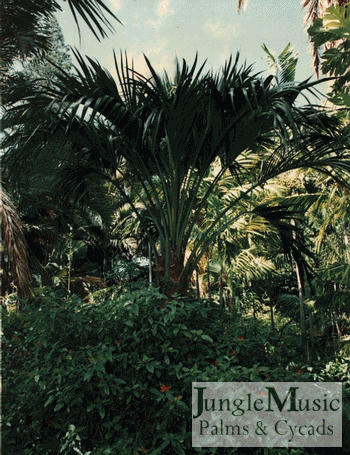
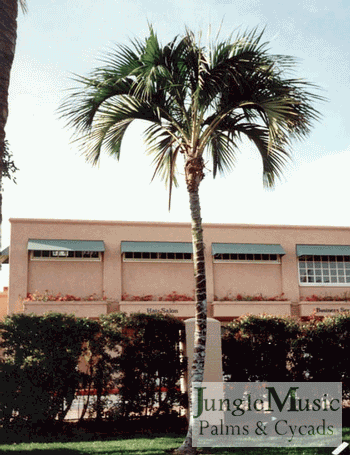
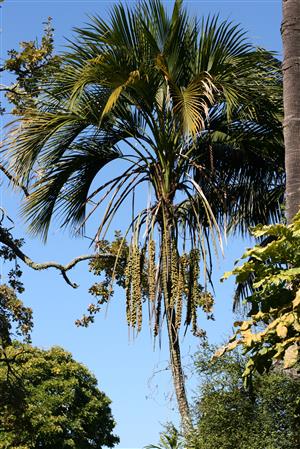
CONCLUSION
Howeas a genus of palms containing two species: Howea forsteriana, the Kentia Palm and Howea belmoreana, the Belmore Palm. Of these two, the Kentia Palm is more popular and commonly used. It makes an excellent palm for coastal Southern California where it tolerates full sun. Inland plants need protection from full sun. The Kentia Palm also makes an excellent house plant. One commonly sees this single trunk palm planted as multiple plants in the same pot or in the ground. They eventually make a medium sized palm, typically up to about 30 feet in sun. They require average water and fertilizer and transplant easily. Diseases are rare and typically easily treated..
We have all sizes of the Kentia Palm for sale, from smaller plants to larger specimen trees. These can be easily shipped right to your door. We have all sizes of the Kentia Palm for sale, from smaller plants to larger specimen trees. These can be easily shipped right to your door.
EASY TO ORDER, 5G
SIZE OF KENTIA PALMS
JUST CALL US AT 619 291 4605
AND WE’LL SHIP TO YOU EITHER
THE SINGLE OR MULTIPLE 5G SIZE.
THESE PLANTS ARE NICELY SIZED – PERFECT HOUSEPLANT.
OTHER SIZES AVAILABLE SHOWN BELOW
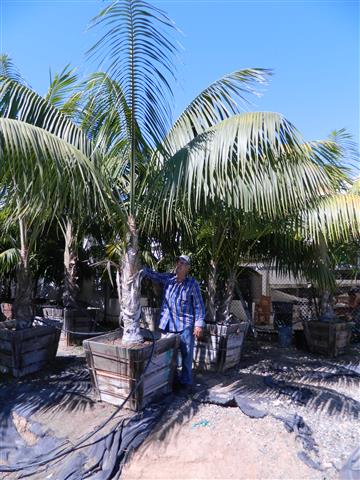


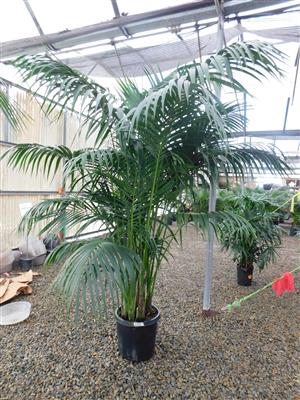

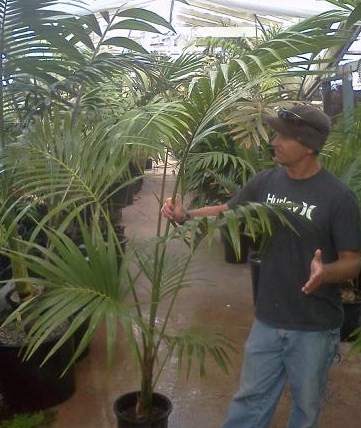

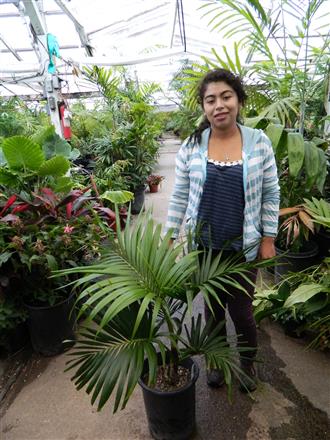
- PALM TREES, CYCADS & TROPICAL PLANT BLOG - October 1, 2020
- TRACHYCARPUS
The Windmill Palm - September 30, 2020 - FAN PALMS –
PALMS WITH CIRCULAR LEAVES - September 29, 2020












